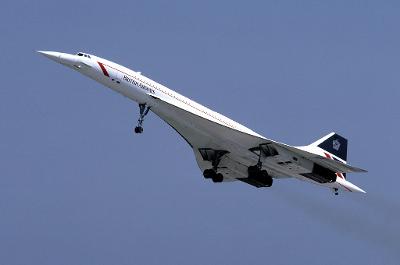Richard Bunclark died at Ashburton in December 1854, at 100 years old. He was 'The oldest inhabitant in the borough'.
Western Times 23 December 1854 p5 col2
* ******* *
John Cooke
'I remembered Mr John Cooke, a saddler and harness maker; he resided in Exeter, and was born in Ashburton, in the County of Devon.'
Reminiscences of John Hele, of Alphington, Devon, John Hele, Exeter, 1870, p9
John Cooke was born at the Rose and
Crown, 'on the old bridge' in 1765. In a pamphlet quoted
by S Baring-Gould, he says that his father was a plasterer and hellier,
but later became a publican and maltster. At the age of 15 John was
apprenticed to an Exeter saddler. A strong loyalist (as opposed to
republican) he later became a well-known character in the city, posting
bulletins of the news outside his shop with his own comments on events.
On one occasion he got his apprentices to help him with ladders to post
notices to the wall of the Castle.
Devonshire Characters and Strange Events, S Baring-Gould, London 1908 p478ff
These placards, noted for their unusual spelling, were known as 'Cooke's Bullenteens'.
Exeter and Plymouth Gazette 28 November 1846 p4 col3
His views were diametrically opposed to those of Richard Carlile, who was also Ashburton born. (See Famous Ashburtonians). Carlile wrote of him: 'His apparent purpose seems to be, to instruct the good people of Exeter in matters of politics!....had he more intellect, his intense mental excitement would bring on that species of insanity which requires restraint.'
The Republican, Vol 12, 1825 p739London Metropolitan Archives October 1792, ref MS 11936/391/605728
In 1834 The Western Times published an agreement between John Cooke and Elizabeth Metherell of Ashburton - Elizabeth's husband was going to America. 'I agree to let her my bake house in the West Street for one year from this Lady day at six pounds a year half of its price. She to heat the oven with coal, not with furze or wood, and if she cannot get on in six months and can afford advance of two pounds a year and so on the original rent of ten pound a year and no more In the main time I shall take no advantage and get her a proper share of the Parish Bread and recommend all my tenants to deal with her and I to do her all the good in my power There is a pig's sty and part of garden with the house.'
The witness to the agreement was Wm. Jordan Taperell (See Inns and hotels for William Jordan Taperell - various spellings - as landlord of the London Inn).
Western Times 27 September 1834 p3 col3
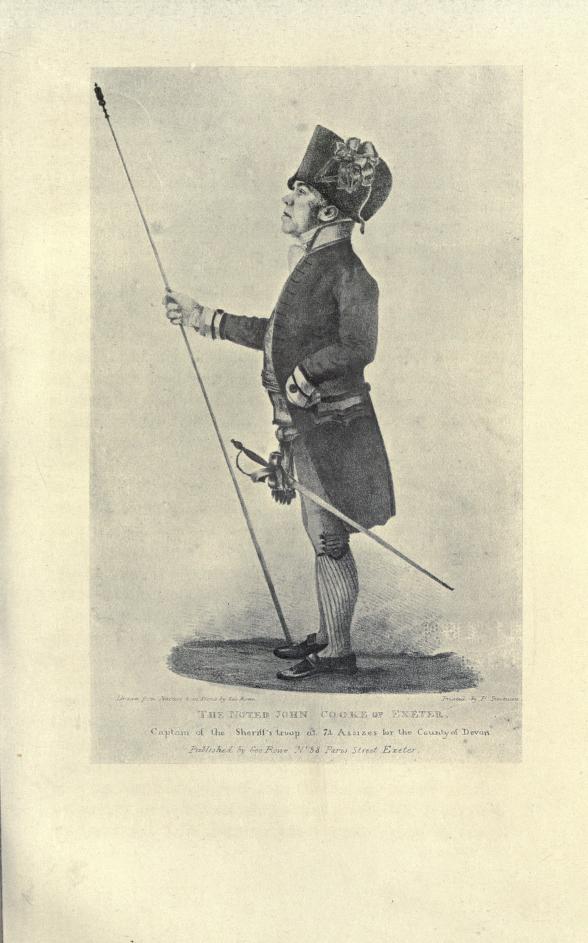
When he died in September 1840 the North Devon Journal described him as a 'very old and respectable inhabitant of Exeter.' Although a saddler and harness maker, he was, said the paper, better known as 'Captain Cooke', from his role of being in charge of the javelin men. The javelin men escorted judges when they went to open the Assize Commission, and John Cooke had been fulfilling this role for fifty years.
North Devon Journal 24 September 1840 p3 col2
*******
Thomas Taylor and Thomas Glanville Taylor
On 14th June 1773 Susan(n)a Glanville was baptized at Ashburton, the daughter of Roger and Mary Glanvill.
https://familysearch.org/
(see Researching Ashburton for two websites on the Glanvill/e family, also under Individual families).
There is a marriage licence at the South West Heritage Centre for Thomas Taylor, late schoolmaster of the Minotaur* and Susanna Glanville of St Andrew in Plymouth, for March 1802.
Ref DEX/7/b/1/1802/114, Devon Heritage Centre
*Believed to be a training ship
Their son Thomas Glanville Taylor was allegedly born
in Ashburton on 22nd November 1804*. According to the Royal
Observatory website, Thomas Taylor Snr. was Assistant to Nevil
Maskelyne, and later to John Pond, and Thomas Jnr. lived at the
Observatory.
http://www.royalobservatorygreenwich.org/ - Accessed 22-1-2015
*However, his age at his death in 1848 was given as 41, giving a birth year of circa 1807. See below
Cambridge
University Digital Library has copies of various letters connected with
the Observatory and Thomas Taylor. According to the inventory, Thomas
Taylor Snr. was Thomas J. Taylor, who was born in 1772.
When John Pond became ill, Taylor 'lapsed into drunkeness'
http://cudl.lib.cam.ac.uk/ - Accessed 23-1-2015
Awards made by the Royal Society of Arts, Manufactures etc.
15 guineas to Mr. T. Taylor of the Royal Observatory, for a repeating alarum
Westmorland Gazette 5 June 1819 p1 col4

Information and image from the Royal Museums Greenwich. http://collections.rmg.co.uk - Accessed 23-1-2015
Image shared under the
Creative Commons Attribution-Non-Commercial-ShareAlike (CC BY-NC-SA) licence
When the number of assistants was increased, Thomas Glanville Taylor joined the staff, on a salary of £100 a year.
In 1830 the Observatory in Madras, run by the East India Company, needed a new Director. Thomas G Taylor was the second candidate approached, and he resigned his position at Greenwich to take up the post. Whilst in India he published a large number of catalogues and volumes of his observations. He married Eliza Baratty Eley on 4th July 1832, and they had four children (three according to other sources). He became a fellow of the Royal Astronomical Society, and was elected a fellow of the Royal Society 10th February 1842.
http://www.royalobservatorygreenwich.org/ - Accessed 22-1-2015
Thomas Glanville Taylor's death was registered in the June quarter of 1848 in the Southampton registration district. His age was given as 41.
.
John Rich, a dealer in rags, died in 1848. For 23 years he had lived in a kitchen in an alley near the market place. He was discovered lying dead on his bed of rags, and at his inquest a jury found that he died of apoplexy. Although he lived in a hovel, he was not a poor man: he had £60 in the Exeter Savings Bank, £200 in the late Totnes Bank and £63 in the Western District Bank. His head was resting on an old pair of breeches with about 40 sovereigns sewed into them. 15 years before he had been robbed of £20 by a woman whom he had invited into his hovel - he had been wary of 'the fair sex' ever since.
Sherborne Mercury 12 February 1848 p4 col4
A John Rich aged 71 died in the March quarter of 1848; probably the same John Rich who is living in North Street in the 1841 census, aged about 65. His occupation on the census is 'Independent'.
https://www.gro.gov.uk
1841 census HO107, piece no. 253, folio 11, p17
*******
A 'scholar and a gentleman'
Sir Harry Luke, Simpson, D. (ed.) (1957), 'The Cobham Cyprus Collection', The Royal Empire Society Library Notes with List of Accessions, New Series no. 12, p. 1-2.
Claude Delaval Cobham, the son of Thomas and Mary Anne, was baptized in Withycombe Rawleigh in August 1843*. A note in the register says he was born on June 30th.
Withycombe Rawleigh Bishop's transcripts
*Records on a previous page suggest it was actually 1842.
In the 1851 census 8 year Claude D Cobham is living at Withycombe Rawleigh with his parents and 5 siblings. A governess and 10 servants are also in the household. Claude was born in Marley, Devon.
1851 census HO107, piece no. 1865, folio 371, p25
In 1861 Claude D Cobham was about to receive an open scholarship, worth £60 a year for five years, for University College, Oxford. Most of his education had been at Chudleigh Grammar School.
Exeter and Plymouth Gazette, 29 March 1861, p6 col4
1868. Claude Delaval Cobham, BA and SCL, was admitted to Holy Orders as a Deacon, in an ordination held by the Lord Bishop of Oxford at Newport Pagnel.
Oxford Chronicle and Reading Gazette, 14 March 1868, p5 col5
By 1871 he is living with his mother in Buckerell parish in Honition registration district.
1871 census RG10, piece no. 2037, folio 77, p10
Claude appeared in the Companion to the Rugby School Register, 1871, (p107), which says that he was the son of Thomas Cobham esq. of Marley Lodge, Exmouth; that he was a Second Rugby Exhibitioner and scholar of Univeristy College Oxford, 1861.
School and University Registers via https://www.findmypast.co.uk
He retired in 1908.
http://www.britishmuseum.org/research/search_the_collection_database/term_details.aspx?bioId=93615 - Accessed 07-04-2018
Sir Harry Luke, Simpson, D. (ed.) (1957), 'The Cobham Cyprus Collection', The Royal Empire Society Library Notes with List of Accessions, New Series no. 12, p. 1-2. Available through https://janus.lib.cam.ac.uk/db/node.xsp?id=EAD%2FGBR%2F0115%2FCobham - Accessed 09-04-2018
The Scotsman, 31 May 1909, p3 col3
The book is available to read at https://archive.org/details/handbookofcyprus00hutc - Accessed 06-04-2018
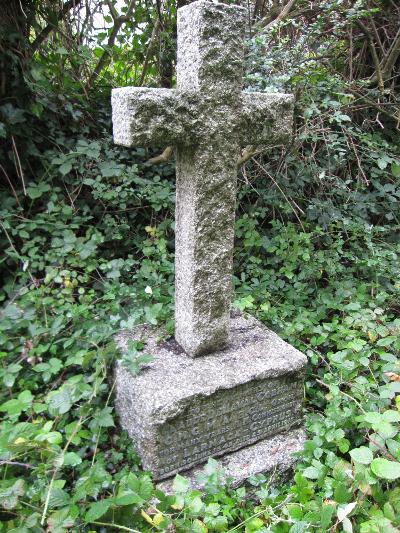
http://www.britishmuseum.org/research/search_the_collection_database/term_details.aspx?bioId=93615 - Accessed 07-04-2018
He was buried at Ashburton on May 3rd, 1915, aged 71*.
Exeter and Plymouth Gazette, 3 May 1915, p5 col6
Parish records
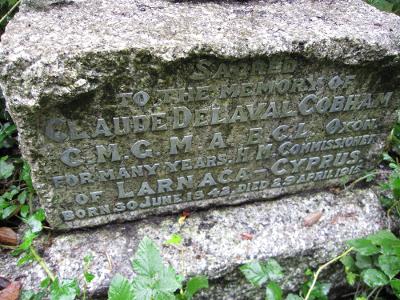
Putting in a search for 'Cobham' on the RAMM website brings up over 70 objects collected by Claude.
http://rammcollections.org.uk - Accessed 07-04-2018
There were several obituaries written in local papers when Henry 'Harry' Mathews Baskerville died in 1962. The Western Morning News headed its tribute, 'The original Baskerville dies, aged 91', and went on to say that as the coachman to Mr B Fletcher Robinson he had driven Sir Arthur Conan Doyle over Dartmoor to gather atmosphere for his story, The Hound of the Baskervilles. Henry's family had a first edition of the book, signed by Robinson (who collaborated on the work) and with an inscription apologising for using Mr Baskerville's name.
Western Morning News 30 March 1962
Over time, Henry's accounts of the writing of 'The Hound', both what he had witnessed and his own participation, perhaps became a little embellished, but he had had a part to play whilst working for the Robinson family in Ipplepen. Later he and his family moved to Ashburton, where he lived for the rest of his life. For the following information (including the newspaper item above) I am heavily indebted to Paul Spiring, who has generously made his research notes on Bertram Fletcher Robinson available to me. He has written (sometimes jointly) several books on Sir Arthur Conan Doyle, Bertram Fletcher Robinson and the character Sherlock Holmes.
Henry Mathews Baskerville's birth was registered in the Newton Abbot district in the March quarter of 1871. He first appears in the censuses at two months old, with his father John (the surname looks like Baskervill), mother Mary Grace and two siblings: 11 year old John and 8 year old Mary Catherine.
Ten years later Henry is a scholar on the census, and the family are living at Smerdons Lane, Ipplepen.
http://www.freebmd.org.uk
1871 census RG10, Piece 2083, Folio 13 P 17
1881 census RG11, Piece 2164, Folio 20, P 6
During 1886 Joseph Robinson employed Henry Mathews Baskerville at Park Hill House, Ipplepen. As a domestic servant he was expected to pump water from a well for the house, polish silverware and clean out fireplaces.
Henry, or Harry as he was known, co-founded the Cottage Garden Society and Ipplepen Cricket Club in 1890, where a year later he was photographed with Bertram Flectcher Robinson.
Information from Paul Spiring
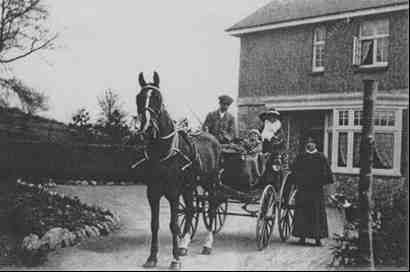
At the end of 1894 Henry Baskerville married Alice Pering in Torquay. They made their home in Ipplepen, near Credefords. By 1901 they had a young daughter Myrtle (Alberta), born in 1895, and were living in 'Chapel Street or Wesley Cottages'. He was still a coachman and domestic (for Joseph Fletcher Robinson). Henry's parents and great uncle still lived at Credefords, and Henry Snr. now describes himself as a retired coachman and domestic.
Later still Henry Jnr. became head coachman with an assistant to help him - the household had three coaches and two horses.
1901 census RG13, Piece 2055, Folio 27, P4
http://www.freebmd.org.uk
Additional information from Paul Spiring
On May 25th of that year Henry collected Arthur Conan Doyle from Newton Abbot Railway Station. Where Arthur Conan Doyle stayed is a matter of debate, (Henry later claimed that he stayed at Park Hill) but Henry did drive the author and Bertram Fletcher Robinson across the moors to research the developing story, The Hound of the Baskervilles.
Henry referred to this visit in a letter to the Western Morning News in 1949.
Article by H J W Dam, Sunday Magazine, New York Tribune, 1905.
Western Morning News 16 February 1949 p2 cols 6,7
Henry received a first edition of The Hound of the Baskervilles from Bertram Fletcher Robinson in 1902. It was inscribed 'To Harry Baskerville from B Fletcher Robinson with apologies for using the name!'
I have spoken to an Ashburton resident who nursed Henry Baskerville in his old age. His daughters showed her this book and its inscription.
In 1906, shortly after the death of Bertram Fletcher Robinson - whose parents had predeceased him - Henry left the Robinson family after working for them for nearly 20 years.
In 1907 he was elected to Ipplepen Parish Council.
Exeter and Plymouth Gazette 28 March 1907 p7 col4
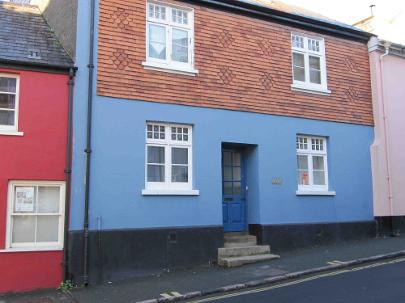
My own photograph 2015
1901 census RG13, piece no 2053, folio 56, p12
Parish records
1911 census RG14, piece 12728
At the time of the 1911 census Henry is a groom gardener, and he and his wife now have a second daughter, Eunice (Freda), born in 1902. 15 year old Myrtle is now a servant for the Fitzpatrick family at Hiram Lodge, East Street.
!911 census RG14, Piece 12727
1911 census RG14, Piece 12727, Schedule Number 20
1911 census RG14, Piece 12727, Schedule Number 63
http://www.freebmd.org.uk
1920 Dorncliffe was sold at auction to Mr H Baskerville for £440.
Exeter and Plymouth Gazette 6 November 1920 p1 col6
In 1924 Properties belonging to the late John Hannibal Foaden came up for sale.
13 St Lawrence Lane sold to Mr Baskerville for £370 - presumably Henry.
Western Times 28 November 1924 p8 col2
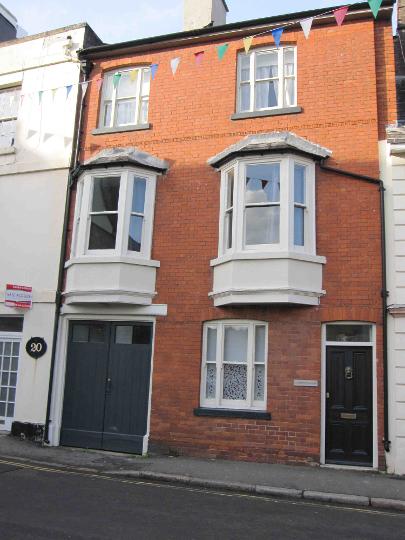
My own photograph, 2015
Information from Paul Spiring
H M Baskerville was one of the coffin bearers at Edward Sawdye's funeral in 1933. Mr Sawdye was said to be of Laburnhams. So many people attended the funeral that some had to stand in the aisles.
Western Times 30 June 1933 p10 col1
1933 Edward Sawdye left various bequests,* dependent on the beneficiaries being in his employ at the time of his death. The newspaper report does not mention Henry Baskerville as one of them.
See Wills, under People and Properties
Henry and Alice Baskerville celebrated their golden wedding anniversary in 1944. A newspaper report stated that the couple had been involved with the Methodist Church all their lives*, and Henry had served on two occasions as Circuit or Mission Steward for the Ashburton section of the South Devon Mission. He had served on the Urban District Council for 6 years, and for 12 years as president of the local Co-operative Society.
Evening Herald, 21 November 1944
* When Ipplepen Methodists held a fete to raise money for renovations, Mr H Baskerville of Ashburton, 'an old member of the church' performed the opening ceremony. Torbay Express and South Devon Echo 4 August 1939 p5 col5
Henry had also been chairman of the Ashburton and District Fanciers' Assocation.
Western Times 2 May 1930 p10 col6
1951. 85 year old Alice Baskerville died, having been ill for some time. The mourners at the Methodist Church included her husband Harry, her daughters Hilda Mann and Eunice Wellington, and Mr and Mrs J Sawdye.
Harry died in 1962, and was buried with his wife in St Andew's churchyard. One of the newspaper obituaries said that he had worked for the Sawdye family for 52 years. The same paper said that photographer Stuart Black had taken his portrait in 1951, and it had been exhibited in London.
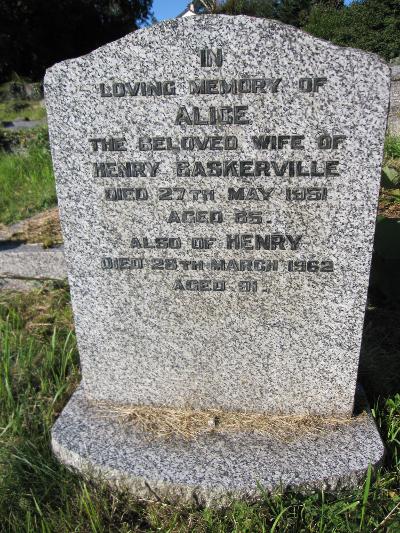
Information from Paul Spiring
See Paul's website at http://www.bfronline.biz and his author page on http://www.amazon.co.uk
***
Hannah Parkhouse
Mrs Hannah Parkhouse of Ashburton died in January 1928, aged 104. She was born on May 29th 1823. Her husband predeceased her 60 years before, at which time she took up nursing. During her nursing career she made her first trip out of Devon, when she went to Cornwall to attend a patient.
Hannah may be living in the Alms Houses, 3, The Grove, Totnes, in the 1911 census. Born in Newton Abbot, she is a former monthly nurse.
By
1927 she was in East Street, when Henry Naylor, the headmaster of the
Grammar School, wrote to the Western Morning News, wondering if she was
the oldest person in the county.
Western Times 20 January 1928 p6 col4
The Engineer, 1956/08/03 https://www.gracesguide.co.uk/Thomas_Bertrand_Abell#cite_note-1
The Engineer, 1956/08/03 https://www.gracesguide.co.uk/Thomas_Bertrand_Abell#cite_note-1
Many thanks to Hazel Bray for the above account
Stanley G Langler had married Maria Lamason in 1920.
